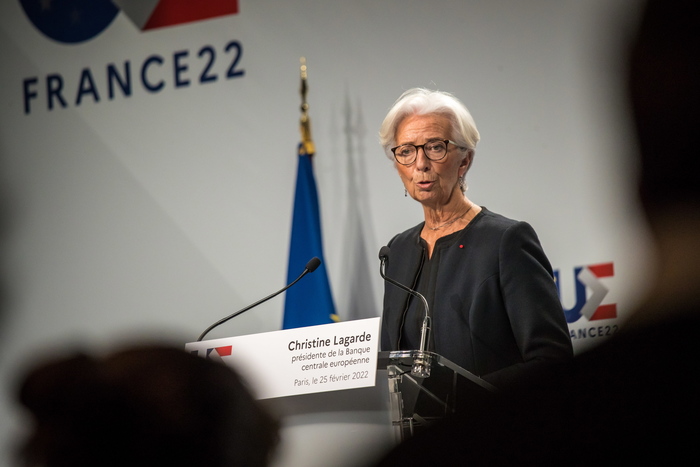The war creates "extreme risks" for the economy but the ECB maintains its course towards a less expansive monetary policy in the face of the risk of hyper-inflation, and heralds a squeeze also for pandemic aid to banks.
Even if all options remain open: including 'ad hoc' measures to contain spreads.
To understand why the Fed and the ECB seem more attentive to the risk of inflation than to that of a recession, we need to go back to the oil shock of the 1970s.
The legacy of which was hyper-inflation also due to the expansive monetary policy of the central banks.
Faced with the current energy shock, the Fed and the ECB do not want to make the same mistake.
Even with an economic scenario precipitated within a month, the pandemic emergency measures are withdrawing.
The Fed has already raised rates.
The ECB, more cautious, will first of all gradually reduce 'new' bond purchases, with a view to eliminating them between July and September, provided that the inflation prospects - which seem increasingly anchored to the medium-term objective of the 2% - do not weaken.
The subsequent rate hike will not be immediate, "but it will happen at a later time".
The picture facing the ECB, today confirmed by the Economic Bulletin, is of growth which, in the basic scenario, stops at 3.7% in 2022 (4.2% was the pre-war estimate) and 2.8% % in 2023.
medium-term target of 2% - do not weaken.
The subsequent rate hike will not be immediate, "but it will happen at a later time".
The picture facing the ECB, today confirmed by the Economic Bulletin, is of growth which, in the basic scenario, stops at 3.7% in 2022 (4.2% was the pre-war estimate) and 2.8% % in 2023.
medium-term target of 2% - do not weaken.
The subsequent rate hike will not be immediate, "but it will happen at a later time".
The picture facing the ECB, today confirmed by the Economic Bulletin, is of growth which, in the basic scenario, stops at 3.7% in 2022 (4.2% was the pre-war estimate) and 2.8% % in 2023.
But there is also a "serious" scenario with growth falling from 5.4% in 2021 to 2.3% this year and next.
S&P, which removed 0.7 percentage points from global growth (3.7% in 2022), has already cut its forecast for the euro area to 3.2%, from 4.4% a few weeks ago.
The SME indices of the Eurozone today signal a resilience (54.5 in February) but also a sharp deterioration in future expectations.
In fact, everything risks worsening with the prolongation of the war and the escalation of sanctions: it is the ECB itself that warns that "the extreme downside risks deriving from a further escalation of tensions could be significant and compromise the global recovery".
But the main concern is that letting inflation go would worsen the economic outlook.
just as happened after the oil shock.
The main scenario of the ECB estimates inflation at 4.1% this year, the "serious" one at 7.1%.
S&P writes 5.1%.
Nobody knows exactly how it will end, now that a 'stop' to gas imports from Russia is also on the table and Moscow responds by asking to be paid in rubles.
For the ECB, at present it is better not to blow on the flames of inflation by continuing with net purchases of debt.
In the absence of surprises that are always possible (such as a global recession caused by the war), the orientation is, from September onwards, to keep open only the channel of reinvestments of the bonds already in the belly in Frankfurt that are reaching maturity.
As Bank of Italy Governor Ignazio Visco has repeatedly pointed out, it is not a monetary tightening and there are various options to contain the negative impact on growth.
The 'normalization' does not spare the banks: the ECB will gradually withdraw - in three phases until 2024 - the measures to support credit during the pandemic, and as early as July the haircuts (haircuts) on collateral will see the 'discount'
pandemic shrink from 20 to 10%.
On the one hand, the ECB is counting on measures to stimulate the economy by the EU: "budget policies must continue to be able to react quickly as the situation evolves".
On the other hand (and the debate is ongoing) precisely on reinvestments that will be targeted towards countries that should see an excessive rise in spreads.
like Italy, which, moreover, in the flight from the risk that rewarded government bonds, from the peak of over 170 on 23 February saw the spread settle back in the 150 zone. (
another point (and the debate is ongoing) precisely on reinvestments that will be targeted towards countries that should see an excessive rise in spreads.
like Italy, which, moreover, in the flight from the risk that rewarded government bonds, from the peak of over 170 on 23 February saw the spread settle back in the 150 zone. (
another point (and the debate is ongoing) precisely on reinvestments that will be targeted towards countries that should see an excessive rise in spreads.
like Italy, which, moreover, in the flight from the risk that rewarded government bonds, from the peak of over 170 on 23 February saw the spread settle back in the 150 zone. (

